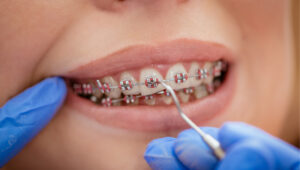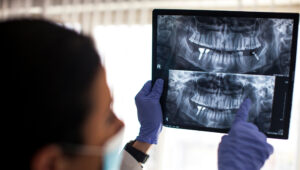What is a Gum Abscess?
A gum abscess is usually caused by bacterial infections and consists of pus-filled sacs. An infection in the root or surrounding area of a tooth can lead to tooth abscesses and cause severe pain. Inflammation occurs in the gums, which surround and protect the teeth. This condition is known as a gum abscess. The gums normally protect us from food debris, but in some cases, this protective barrier is damaged, and bacteria can move freely, leading to a gum abscess.
What Causes These Abscesses?
The main causes of gum abscesses include: Food Debris: Small food particles that get trapped between teeth and gums are a great breeding ground for bacteria. If not cleaned, these particles allow bacteria to grow and cause infections. Physical Trauma: Any injury or impact to the gums can create a pathway for bacteria to enter. Tooth Decay: If decayed teeth are left untreated, infections can spread to the gums. Gingivitis and Periodontitis: Gum inflammations can lead to abscesses. Sugary Foods: Frequent consumption of sugary foods and carbonated drinks can increase the risk of developing gum abscesses.
What Are the Symptoms of an Abscess?
A person with a gum abscess may experience the following symptoms:
- Pain, especially radiating to the jaw, ear, or neck area
- Redness and tenderness in the gums
- Bleeding gums
- Swelling in the face
- Fever and bad breath
- Swelling of lymph nodes in the neck
How is a Gum Abscess Diagnosed?
A thorough examination by a dentist, along with necessary radiological tests, can be used to diagnose gum abscesses. It is crucial for the dentist to differentiate gum abscesses from other health problems that may mimic similar symptoms. If a gum abscess is suspected, an X-ray is typically performed. If the infection has spread to surrounding areas, a more detailed imaging technique such as a CT scan may be used.
How is It Treated?
Treatment for a gum abscess focuses on draining the pus and treating the underlying infection. Your dentist will drain the abscess and create a treatment plan for the infection source. This may include special treatments like root canal therapy or fillings, as well as medications and surgical interventions. If the tooth can be saved, a root canal will be performed. If the tooth cannot be saved, it may be extracted. Rinsing with salt water and applying cold compresses are some temporary at-home treatments. These methods provide temporary relief, so it is essential to consult with a dentist.
Prevention Methods Maintaining good oral hygiene is the best preventive measure. Regularly brushing your teeth and using dental floss can significantly reduce the risk of these issues.







